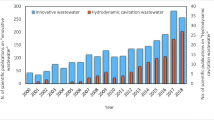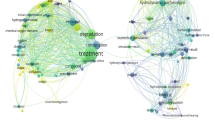Abstract
Degradations of refractory pollutants by hydrodynamic cavitation were experimentally carried out in a self-developed hydrodynamic cavitation reactor with Venturi tubes, multi-orifice plates and their combinations. Effects of hydraulic elements of cavitation due to the Venturi tube on degradation of refractory hydrophobic pollutant were studied, and an optimal throat length corresponding to the maximum degradation rate was obtained. Effects of cavitation due to number, size and distribution of orifice for the multi-orifice plates on degradation of refractory hydrophilic pollutant were investigated, and comparisons and analyses were made. Effects of cavitation due to different combinations of the Venturi tubes with the triangular multi-orifice plates on degradation of hydrophilic and hydrophobic mixtures were studied, and an appropriate combination was determined. Also, effects of cavitation duration, pH value and initial concentration on the refractory pollutants were explored.
Similar content being viewed by others
References
Talaiekhozani A., Bagheri M., Goli A. et al. An overview of principles of odor production, emission, and control methods in wastewater collection and treatment systems [J]. Journal of Environmental Management, 2016, 170(1): 186–206.
Wang C., Zheng S. S., Wang P. F. et al. Effect of vegetations on the removal of contaminants in aquatic environment [J]. Journal of Hydrodynamics, 2014, 26(4): 497–511.
Dular M., Griessler-bulc T., Gutierez I. et al. Use of hydrodynamic cavitation in waste water treatment [J]. Ultrasonics Sonochemistry, 2016, 29(3): 577–588.
Goel M., Hu H. Q., Mujumdar A. S. et al. Sonochemical decomposition of volatile and non-volatile organic compounds: A comparative study [J]. Water Research, 2004, 38(19): 4247–4261.
Sheme H., Narkis N. Sonochemical removal of trihalomethanes from aqueous solutions [J]. Ultrasonics Sonochemistry, 2005, 12(6): 495–499.
Inoue M., Okada F., Sakurai A. et al. A new development of dyestuffs degradation system using ultrasound [J]. Ultrasonics Sonochemistry, 2006, 13(4): 313–320.
Mason T. J. Large scale sonochemical processing: aspiration and actuality [J]. Ultrasonics Sonochemistry, 2000, 7(4): 145–149.
Dong Z. Y., Liu Z. H., Wu Y. H. et al. An experimental investigation of pressure and cavitation characteristics of high velocity flow over a cylindrical protrusion in the presence and absence of aeration [J]. Journal of Hydrodynamics, 2008, 20(1): 60–66.
Soares A. K., Martins N. M. C., Covas D. I. C. Transient vaporous cavitation in a horizontal copper pipe [J]. Journal of Hydraulic Research, 2017, 55(5): 731–736.
Pawar S. K., Mahulkar A. V., Roy K. et al. Sonochemical effect induced by hydrodynamic cavitation: Comparison of Venturi/orifice flow geometries [J]. AIChE Journal, 2017, 63(10): 4705–4716.
Dong Z. Y., Su P. L. Cavitation control by aeration and its compressible characteristics [J]. Journal of Hydrodynamics, 2006, 18(4): 499–504.
Dong Z. Y., Chen L. Cavitation characteristics of high velocity flow with and without aeration on the order of 50 m/s [J]. Journal of Hydrodynamics, 2007, 19(4): 429–433.
Sun X., Park J. J., Kim H. S. et al. Experimental investigation of the thermal and disinfection performances of a novel hydrodynamic cavitation reactor [J]. Ultrasonics Sonochemistry, 2018, 49(12): 13–23.
Suslick K. S. Sonochemistry [J]. Science, 1989, 247: 1439–1445.
Lü M. N., Didenko Y. T., Suslick K. S. Sonoluminescence temperatures during multi-bubble cavitation [J]. Nature, 1999, 401: 772–775.
Pandit A. B., Joshi J. B. Hydrolysis of fatty oils: effect of cavitation [J]. Chemical Engineering Science, 1993, 48(19): 3440–3442.
Kumar P. S., Kumar M. S., Pandit A. B. Experimental quantification of chemical effects of hydrodynamic cavitations [J]. Chemical Engineering Science, 2000, 55(9): 1633–1639.
Vichare N. P., Gogate P. R., Pandit A. B. Optimization of hydrodynamic cavitation using a model reaction [J]. Chemical Engineering Technology, 2000, 23(8): 683–690.
Dong Z. Y., Hu J. J., Zhang Z. et al. Effects of circular multi-orifice plates on degradation of mixture wastewater due to hydrodynamic cavitation [J]. Journal of Zhejiang University of Technology, 2014, 42(3): 291–293(in Chinese).
Dong Z. Y., Xu L. X., Li D. W. et al. Experimental study on degradation of PNP by hydrodynamic cavitation due to circular multi-orifice plate [J]. Journal of Zhejiang University of Technology, 2015, 43(3): 275–278(in Chinese).
Yao R. H., Dong Z. Y., Zhang K. Effect of hydrodynamic cavitation due to multi-orifice plates on degradation of chemical wastewater [J]. Environmental Pollution and Control, 2015, 37(9): 5–8(in Chinese).
Rinaldi L., Wu Z., Giovando S. et al. Oxidative polymerization of waste cooking oil with air under hydrodynamic cavitation [J]. Green Process Synth, 2017, 6(4): 425–432.
Suryawanshi P. G., Bhandari V. M., Sorokhaibam L. G. et al. Solvent degradation studies using hydrodynamic cavitation [J]. Environmental Progress and Sustainable Energy, 2017, 37(1): 295–304.
Author information
Authors and Affiliations
Corresponding author
Additional information
Project supported by the National Natural Science Foundation of China (Grant No. 51179172).
Biography: Zhi-yong Dong (1962-), Male, Ph. D., Professor
Rights and permissions
About this article
Cite this article
Dong, Zy., Zhang, K. & Yao, Rh. Degradation of refractory pollutants by hydrodynamic cavitation: Key parameters to degradation rates. J Hydrodyn 31, 848–856 (2019). https://doi.org/10.1007/s42241-018-0131-5
Received:
Revised:
Accepted:
Published:
Issue Date:
DOI: https://doi.org/10.1007/s42241-018-0131-5




